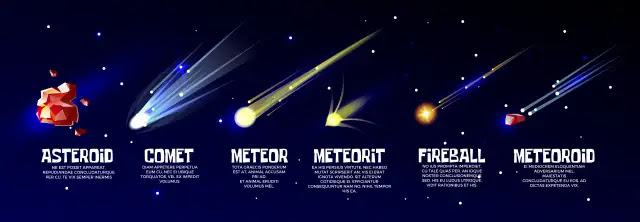Facts About Meteoroids: Meteors are particles of debris ranging in size from sand grains to giant boulders scattered throughout the Solar System. When these small and large objects are pulled by the Earth's gravity, they show a luminous path of their fall due to the friction of the atmosphere, which in common parlance we call "shooting stars" or "meteorites". This object (meteoroid) sometimes reaches the ground without completely burning up in the atmosphere, which is also called 'meteorite'.
Approximately 2.5 million meteorites, asteroids, and other space debris enter Earth's atmosphere each day, resulting in approximately 15,000 tons of material entering the atmosphere each year.
Interesting Facts About Meteoroids
- A meteoroid can reach up to 10m in diameter.
- Meteors usually burn up in the Earth's atmosphere.
- Meteors that burn brighter than usual are called fireballs.
- The fastest meteoroids can travel up to 94,000 miles per hour.
- Meteoroids are similar to asteroids but significantly smaller.
- Millions of meteoroids impact the Earth’s atmosphere every day.
- The Earth’s atmosphere experiences millions of meteors every day.
- Meteors can become visible as high as 120 kilometers above Earth.
- During the lower light conditions, it becomes easy to see meteors.
- There are millions of meteors in the Earth's atmosphere every day.
- A meteor shower is usually the result of debris from a broken comet.
- Meteors are easier to see during the lower light conditions of night.
- Usually meteors are the size of pebbles and no larger than a baseball.
- The word meteor comes from a Greek word that means suspended in the air.
- There are three different types of meteorites: – stony, iron, stony-iron.
- A meteor shower occurs when a lot of meteors appear in a short time frame.
- The fastest meteoroid travel through the solar system at a speed of around 26mph.
- There are three common types of meteorites, and they are stony, stony-iron and iron.
Scientific Facts About Meteoroids
- Most fireballs go unseen because they occur over the ocean or during daylight hours.
- The largest intact meteorite is Hoba, is an iron meteorite that weighs over 132,000 pounds.
- When meteoroids shed by a comet orbit together in a formation, is called a meteoroid system.
- Two big meteor showers occur each year: the Perseids in August and the Geminids in December.
- A large majority of the meteoroids in our Solar System are fragments of asteroids and comets.
- Meteors can give off various colors when they burn which is associated with their composition.
- Most meteors fall in the ocean because the Earth's surface is covered by more water than land.
- A meteor (falling star or shooting star) is a meteoroid that has entered the Earth’s atmosphere.
- Many meteor showers occur when comets leave debris behind while orbiting through the solar system.
- A meteorite is a meteoroid that survives entry into the Earth’s atmosphere and impacts the surface.
- A meteoroid is a small astronomical body in outer space that is made out rock or metallic materials.
- When many meteors occur in a close time frame in the same part of the sky it is called a meteor shower.
- A meteor will become visible to the naked eye between 250,000 and 390,000 feet above the Earth’s surface.
- When a meteoroid hits the atmosphere of the Earth, it can be travelling as fast as 130,000 mph (209,215 km).
- If a meteor produces a sound called a sonic boom, it is typically heard seconds after the meteor becomes visible.
Amazing Facts About Meteoroids
- Although meteors have existed since ancient times, they were not believed to be from our Solar System until 1833.
- More than 500 meteorites reach the surface of our planet every year but only 1% of them make it to scientists for study.
- Of the 500 estimated meteorites that reach the ground every year, only five or six are recovered for scientists to study.
- When a large number of meteors occur in a particular part of sky in a close time frame then it is called a meteor shower.
- The fastest meteoroids travel through the solar system at a speed of around 42 kilometres per second (26 miles per second).
- Around 500 meteorites reach the Earth’s surface every year but of those only around 5 ever make it to scientists for study.
- A meteoroid that survives falling through the Earth’s atmosphere and colliding with the Earth’s surface is known as a meteorite.
- Dinosaurs are believed to have died because an 8 mile long meteor hit the Earth causing a cloud of dust that lowered the climate.
- There are about 60,000 meteorites found on Earth. Out of that number, around 126 of them are believed to be from the red planet, Mars.
- A meteorite that is seen or detected as it lands are called “falls”, with those that are discovered later being referred to as “finds”.
- The blast caused by the shockwaves of the Chelyabinsk meteor in Russia was picked up by infrasound sensors on the other side of the world.
- Taoudenni 002 is the largest Martian meteorite found on Earth. Discovered in 2021, this uncut meteorite weighs 32 pounds or 14.5 kilograms.
- Millions of meteoroids travel through the Earth’s atmosphere every day, but most are small and burned up quickly. Very few reach the ground.
- Space rocks that are less than 1 meter in diameter are called meteoroids. Those that are more than 1 meter in size are classified as asteroids.
Mind-Blowing Facts About Meteoroids
- A meteor will either deflect off the Earth’s atmosphere and go back into space, burn up completely or impact the surface and become a meteorite.
- A few meteoroids follow a path that goes into the atmosphere of our planet and then back out again. They are called earth grazing balls of fire.
- The Orionid meteor shower, commonly just called the Orionids, is a popular annual meteor shower that is created from the debris of Halley’s Comet.
- A small percentage of meteoroids fly on a path that goes into the Earth’s atmosphere and then back out again, they are known as Earth grazing fireballs.
- Most meteoroids are made of silicon and oxygen or metals like nickel and iron. Metallic meteoroids are dense and massive as compared to stony meteoroids.
- As of April 2017, the International Astronomical Union (IAU) defines an astronomical body a meteoroid if it has a diameter between 0.003 centimeter and 3.28 feet.
- The unique Venus flytraps are thought to have extraterrestrial origins. That is because these carnivorous plants are often found in areas where meteorites have fallen!
- A meteor shower is when multiple meteors enter the Earth’s atmosphere at the same time and in the same area, appearing to be coming from the same point of the night sky.
- A meteoroid is a chunk of space rock. When it burns up while entering the Earth’s atmosphere, it is called a meteor. And if a piece of it lands, it’s called a meteorite.
- The Chelyabinsk meteor exploded over Russia on February 15th, 2013. It released energy equivalent to 26 to 33 times the energy of the atomic bomb dropped on Hiroshima, Japan.
- The buying and selling of meteorite pieces in South Africa is illegal. It is also illegal to export meteorites that landed in Australia as they are considered “property of the Crown.”
- One of the most well-preserved impact craters is the Barringer Meteor Crater in Arizona. The fragments from the object that made this depression are called the Canyon Diablo meteorite.
- A meteoroid is a small rock or particle of debris in our solar system. They range in size from dust to around 10 metres in diameter (larger objects are usually referred to as asteroids).
- Meteoroids are also created from impact debris that gets injected into space. An example of how impact debris can be created is by an asteroid striking a planet or natural satellite (moon).
- The impact that made the Chicxulub crater has a size around 11 to 81 km in diameter. It was said that the energy blast that it caused is equivalent to around 21 to 921 billion times the Hiroshima bomb.
- The largest meteor air burst was the Tunguska event. A meteor exploded near the Podkamennaya Tunguska River in Siberia, Russia on June 30th, 1908. The explosion released the energy equivalent to 10 to 15 megatons of TNT.
- Meteorites that are observed as they fall through the Earth’s atmosphere and later recovered are called ‘falls’, all others are called ‘finds’. To this date there have been around 1000 collected ‘falls’ and 40000 ‘finds’.
- A meteoroid that burns up as it passes through the Earth’s atmosphere is known as a meteor. If you’ve ever looked up at the sky at night and seen a streak of light or ‘shooting star’ what you are actually seeing is a meteor.
- About 66 million years ago, about 60% of life on Earth vanished because of a large asteroid impact. It is believed to be the event that made the dinosaurs extinct. The impact occurred in the Yucatán Peninsula which left the Chicxulub crater.
- A meteorite will hit a human being once every 180 years according to a study by Nature done in 1985. With Ann Hodges the only confirmed person to be hit by a meteorite in 1954, that means the next time somebody will be hit by a meteorite is 2134—an average of .0055 per year.
- It is estimated that about 48.5 tons or 44 tonnes of debris from space fall to Earth every day. About 99% of this is made up of micrometeorites. These are dust-sized and even microscopic meteorites that are all around us. Because they are so small, it is easier to find them in remote places like deserts and Antarctica.
Friends, hope you liked this post on Interesting Facts About Meteoroids. If you liked this post, then you must share it with your friends and Subscribe to us to get updates from our blog. Friends, If you liked our site FactsCrush.Com, then you should Bookmark it as well.














0 Comments